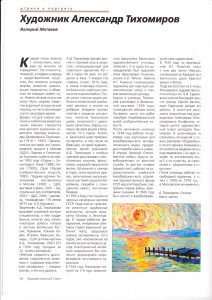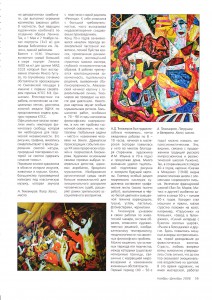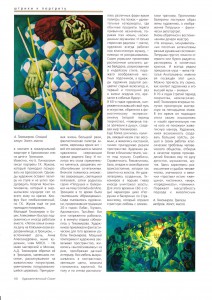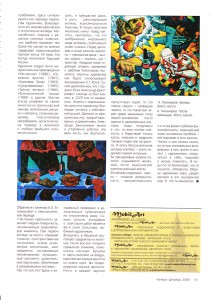Valery Matveev
“Artcouncil” magazine, # 6, 2006.
Each epoch is associated with personalities, to a large extent defining it. This statement is probably most relevant when it comes to the workers of art, without which the history is dead, development of civilization is hampered and the society fails to find its own way. Names of the masters of art might be broadly known during a certain historical period, but more often they come up after some time.
I believe that the name of the Russian artist of the Soviet times Alexander Dmitrievich Tikhomirov (1916 – 1995) becomes one of such names for many art experts and amateurs. Life exhibitions of his works took place in Moscow (Central House of Artists), Paris and Leningrad (within ‘Paris – Leningrad’ exhibition project of 1993), Rome (1989), Seoul (1995) and Oryol (Fine Arts Museum, 1985). Later on Tikhomirov’s paintings were exhibited in Moscow (2000 – Central House of Artists, ‘Circus’ exhibition, 2001 – Central House of Writers, 2002 – Central House of Artists, 2004 – exhibition devoted to 175th anniversary of Bauman Moscow State Technical University).
The art of A.D. Tikhomirov attracts enormous interest of specialists, there is a movie and a number of articles devoted to the artist, some of his works have been acquired for private collections in Russia, Germany, South Korea, Italy, France, Canada and USA.
‘I dream of combining the achievements of contemporary art with the world’s classical heritage’, – the master used to say, and that’s what he managed to achieve. A.D. Tikhomirov has walked a long and complicated way in art, not traditional for a Soviet artist of 40-90-es of the XX century. He was born in Baku in January, 1 (Old Style), 1916, in the family of a construction engineer working in the Baku oil field, and a housewife. After six classes of school he worked at the Pictorial Art Studio and studied at the worker’s faculty. One of his first professional experiences was involvement in design of promotional posters of Baku circus, where he met the circus artists, images of which enriched his art of the 70-es. By the way, Baku circus was often visited by the artists from different countries, for instance France, who brought with them their bright highly artistic advertisements. A.D. Tikhomirov spoke excitedly about performances of the clowns and illusionists, as well as about life in circus behind the curtains. He was recalling horse races high in the mountains, boyish scuffles, religious Muslim processions accompanied by the rhythm of the drums, weddings with bride kidnapping and the oriental markets.
In 30-es Baku turned into one of the USSR’s largest cultural centers. Famous foreign musicians and the best musicians of Moscow and Leningrad willingly visited the city. There was a philharmonic hall in the city, Baku Worker’s Theatre performed very interesting plays, continuing the most daring experiments of the 20-es, which became impossible to effectuate in the centre or political reasons. Undoubtedly, favorable life microclimate formed the world view of the young artist.
In 1934 Tikhomirov entered the 2nd course of studies at the pictorial art department of Baku Art College. Starting from the 3rd year he studied under supervision of Ilya Gerasimovich Ryzhenko, the student of I.E. Repin. It was I.G. Ryzhenko who helped the young artist to obtain ‘firm’ realistic school and develop art culture. During his studies at the College, Tikhomirov participated in the Pictorial Art Exhibition of 1935, devoted to the anniversary of Shota Rustaveli; six of his works have been acquired by Azerbaijani Fine Arts Museum.
Having graduated from the college in 1938, he was contracted to do the paintings for Azerbaijani Antireligious Museum and continued doing freelance works for the circus. During the Great Patriotic War, being excempted from military service (he lost his right eye in the childhood) he worked at the Art Concern of the Azerbaijani Department of the USSR Art Foundation, painting promotional posters, portraits of the war heroes, war scenes. In 1944 he became a member of the Azerbaijani Council of Artists.
In 1945, upon invitation of I. Ryzhenko, joined him during his work on two panel-paintings ‘Defeat of German troops on Caucasus’ for Baku House of the Red Army and Fleet. During the same period he entered the 3rd years of studies at the Surikov Moscow Art Institute, mainly because his works have been previously seen by Sergey Vasilyevich Gerasimov, the principal of the institute. At the institute he was a student of Alexander Alexandrovich Osmyorkin, who acknowledged artistic talent of young Tikhomirov. Later on, he failed to establish good relationships with the new principal Modorov, on an order of whom Tikhomirov was expelled for academic failure (he did not pass the exam in English), but, as a matter of fact, for proneness to ‘formalism in the art’.
After the college he worked as a freelance artist and from 1949 to 1976 – at the Moscow Monumental-Decorative Art Concern, where he performed a great number of orders. In particular, he was the leading artist of the concern in charge of Lenin’s images. For instance, on occasion of 1st of May and 7th of November he painted the portraits (3 x 3 m) on the frontage of the Lenin Library and the premises of the district committees.
Together with I.M. Ilyin he performed the world’s largest Lenin’s portrait (600 sq. m.) for the building of the Ministry of Foreign Affairs of the USSR, which gained excited comments of Renato Guttuso, who happened to accidentally drive across Smolenskaya square in one car with V.V. Grishin, the First Secretary of the City Committee of the Communist Party of the Soviet Union. Later on, upon nomination of the Culture Department of the City Committee of the Communist Party of the Soviet Union, this work, performed on special strips, has been awarded with the Golden Medal of the Exhibition of Economic Achievements.
Official orders allowed the artist to enjoy certain financial freedom, so much needed for creative independence. His drawings, graphics and paintings are speaking about a bright genius of a fearless person, whose natural temper could not be suppressed by any ‘isms’.
The artist possessed impressive knowledge in the field of the history of arts, pictorial art and music. In fact, most of his works have been created to the strains of classical music from the records of the old radio and record player ‘Regonda’. He was very demanding to himself, often expressing discontent with the paintings he has been working on.
End of the 70-es was marked by beginning of the period of magnificent pastous paintings, full of a rave of colour, penetrated by the life dynamics, embodied by a passionate stroke of the master and deep psychological essence of the characters. The paintings are characterised by compositional perfection, thorough solutions and precise balance. Aivazovsky started his paintings from a horizontal line, while Tikhomirov put two diagonal lines across the canvas. Some of the paintings sound with a special musical rhythm. Most of the works, especially in 70-90-es, are filled with deep philosophic content, the ‘keyhole’ problem is not an issue here, however, they pose more global questions – place and designation of a man on the Earth. Dramatic nature of events which are to happen at the end of the XX century found a prophetic reflection in A.Tikhomirov’s art. The painter has chosen theatric artists, circus acrobats and street musicians as his main heroes. Depiction of the artistic environment gives broader opportunities for emotional discovery of the human souls, expanding the frames of the spectators’ associative perception. A.D. Tikhomirov had a high working capacity, he worked almost 8-10 hours each day, starting at the workshop (which he got to a large extent due to the efforts of the artist I.M. Ilyin in 70-es) and continuing at home. He paid much attention to thorough preparation of the pattern and color of the future painting. That is why graphic sheets performed in black and white, colored and mixed techniques using the pencil, ink, charcoal, pastel, markers and writing ink comprise a special part of creative heritage of the artist. A. Tikhomirov is easily recognizable in his works through his painting style, systems of images, expressive temper and ambiguity of posed philosophic questions. Three main periods of his creative development may be distinguished, separated by invisible borders related to correction of his world outlook and change of life circumstances.
First period (40 – 50-es) may be called an impressionistic one. This is possibly related to continuation of tradition of Russian impressionism and Ryzhenko’s realistic school. For instance, we can see signs of realistic school with elements of ‘Serov’s’ painting style in extant sketches of the 40-es and the picture ‘Horse riding in Mozdok’ (1948). Interest in a French school (Van Gogh, Marguet, Matisse, etc.) is especially noticeable at the end of the 50-es – beginning of the 60-es. The colors became strong and bright, the stroke is passionately laid on the canvas, for example, in ‘Sailboats on Klyazma’, ‘Factory in Gelenzhik’, ‘Blue interior with the bouquet of golden balls’, ‘Market in Gelenzhik’ and others. Here we see new powerful accords of expressionism, sometimes up to fauvist canvas. Passion and love against all odds were so strongly imposed on these paintings that they still have a powerful emotional impact on the spectator. As he did not have his own workshop during this period, the artist worked in a room of the communal flat in Bryusov lane or in his cabin in Troitskoye.
As known, B. Pinkhasovich was painting the portraits of G.K. Zhukov, who used to come to Bryusov lane to pose. Once the artist left his palette on the chair and did not warn Georgy Konstantinovich, who came and sat smashing on the colors right in his marshal uniform. This was a terrible embarrassment, but G.K. Zhukov came posing again many times after that.
Young Tikhomirov and Boris Alexeevich quickly became friends and sometimes worked together. ‘In summer the family was renting out a cabin by Klyazma water reservoir, in Troitskoye village, – memorizes the daughter, Anna Alexandrovna, presently an artist, member of the Moscow Union of Artists, – not having a workshop in Moscow, A.D. Tikhomirov obtained it in Troitskoye, a small village spread along picturesque peninsula with half-ruined church on top of it. An intricate life of a large river, fantastic palette of sunsets, a row of bright yachts – all this revived the painter’s memories of glittering colors of his home town Baku. And his palette started changing swiftly, blossoming out in unusual combinations. He started by painting many glittering and glowing landscapes, then created ‘Petroushka and the ballet dancer’ series on Сomedia del Arte theme. Troitskoye of that time was a “smaller Abramtsevo”. It was a meeting spot for painters who were followers of the traditions of the 20-es: Labas, Glouskin, Adlivankin, Talberg. They all worked hard and gathered together at Tikhomirov’s place for a moment’s rest. Painters were attracted by Tikhomirov’s works which looked fantastic for that time. His overpowering temperament captures space, paintings ‘spilled out’ of frames, transforming interior of the house. All furniture acquired contrast ringing colors, the whole room turned into a picture. Bright palettes of various shapes settled on the floor and the walls. All over the shelves there were marvelous still lives, where usual objects lost their ordinary designation, striking our eye-sight with a new and unexpected perception. The only thing that was never colored was the old radio and record player – a sacred thing to the painter, who would always work to classic music. The garden was decorated with whimsically painted beach chairs, even the kayak, painted in Indian style, striking imagination of the local boatmen, and one day the artist made a rainbow painting on an old bicycle, and, trying to ride it for the first and the last time, ran into the doghouse’. In 60-es Tikhomirov, who was in intense search of his way in the art, turned to fauvist expressionism (second period of his creative development), ‘having turned his eyes into his very soul’, working on creation of Tikhomirov’s world.
His palette became stronger, each stroke gained more weight, and his paintings – more pastous, lines cutting the space in a fanciful manner. The artists worked at a crazy speed, often to the music of Scriabin, Stravinsky, Rakhmaninov, Bach, falling into sort of trans condition so noticeable on his canvas. Not being satisfied with what he created, sometimes Tikhomirov destroyed the canvas in a blaze of anger. This period (60-es) is characterized by ‘Petroushka and the ballet dancer’ cycle to Stravinsky, which reflected his passionate love with tragic elements. The artists used the image of his wife as a prototype of the ballet dancer and his depiction of Petroushka is practically a self-portrait.
Let’s revert to the memories of the master’s daughter again. ‘Powerful, monumental canvas capture various states of the soul: Petroushka is grieving, languishing from the passion or exults, dissolving in sunny colors. And always by his side is a beautiful muse – his wife Natalya Anatolyevna; it is her to whom the cycle is devoted to. One can read this cycle as contact of the artist with his supreme muse – anima’.
In 70-es (third period of creative development, neoclassical) Tikhomirov for the first time in his life got a spacious workshop on the fifteenth floor. At those times he accomplished his search and found an original, ‘unlike any other’ painting style. Not having an opportunity to create large canvas, the artist addressed classic problems of human society in his works, choosing the artists, musicians and motleys, so congenial to him, as the main characters. Typical sign of these paintings is thinking about the destinies of a humankind, significance and greatness of ‘simple’ verities: ‘woman’, ‘beginning’, ‘world’, ‘decency’, ‘prisoner’. Immensity of his approach to pictorial problems is striking, all the periods of the artist’s creative development are synthesized here, his world outlook and esthetic views become focused. Immensity of his approach to solution of complex pictorial problems is amazing as the master in many respects foresaw oncoming tragic developments of the end of the XX century. He has always been concerned about the future of Russia.
Paintings created by the artist, are almost monumental: ‘Exile’ (1980), ‘Derision of Christ’ (1981), ‘Queen of Clubs’ (1983), ‘Middle Ages’ (1985), ‘Lord’s Supper’ (1986), ‘Fantastic City’ (1988) and others. The master is always recognizable by his pictorial-philosophic style, composition, pattern and color, complex solution, plastic uniqueness, artistic approach in art and the depth of real life reflection. Let’s revert to the notes of A.A. Tikhomirova referring neoclassical period.
‘Pastose coloring is replaced by a smooth surface, which reminds one of a medieval painting. At the first glance at the canvasses one gets struck by a complicated spacious structure, an acute asymmetry in the composition, chaos of objects that make up the unique musical ornament, astonishing personages dressed in medieval costumes. What is it all about? All are there – the king, the beautiful dame and the motleys. Shakespearean motives, existential themes. Having only stood in front of the canvass for several minutes, you feel that you are facing a display of a human inner world, of the profound layers of psychics. The spectator is facing archetypes that froze while dancing: the wonderful lady is an anima, the king is selfness, the clown is a trickster. Not without reason he raises such an interest with psychologists; the painter’s pictures give the impression of serving as an illustration of K. H. Jung’s works. What is most astonishing is that Alexander Dmitriyevich never knew Jung’s works; they weren’t published in the USSR. Communication with the subconscious is all known to him due to his dialogue with his own inner world. Being so distant to the official games, alien to career aspirations, Alexander Dmitrievich worked hard and was stuck in his work, his brush lead him like Virgil, – a reliable guide in fascinating voyage around the inner space. Shakespeare’s 66th sonnet, so much admired by the artist, is the best epigraph to this series of works. Take a closer look at the reckless whirl of objects on the paintings. Almost all of them have lost their traditional meanings, have changed places: bottles and cards have soared into the air; the king’s crown is whirling on the clown’s shin. This is how false values get profaned. Almost every picture has a scull: here, it is a dance of the death with flying sculls; there, it is an empty-eyed scull among the mannequin-like people with their eyes shut. Strangely dressed people are often deeply asleep; their eyelids are closed, and awake are only the dolls, who stare at the spectator with their lively and wise eyes. And again we face an unconscious guess of the master for ages – a doll has for a long time symbolized intuition. Fanciful pattern of the paintings conceives an iron, almost classical compositional framework. Phosphorescent paint – powerful ornamentality, monumentality and at the same time deep philosophicity, the broadest coverage of life problems – everything is striking in these paintings. We can write a lot about them, but it would be much better, if, having a closer look at them, you come in contact with the artist, submerge in yourself, think about life and dream… And then something will happen, something will appear. The artist’s images are calling, leading the spectator into his inner world. And then something changes’.



